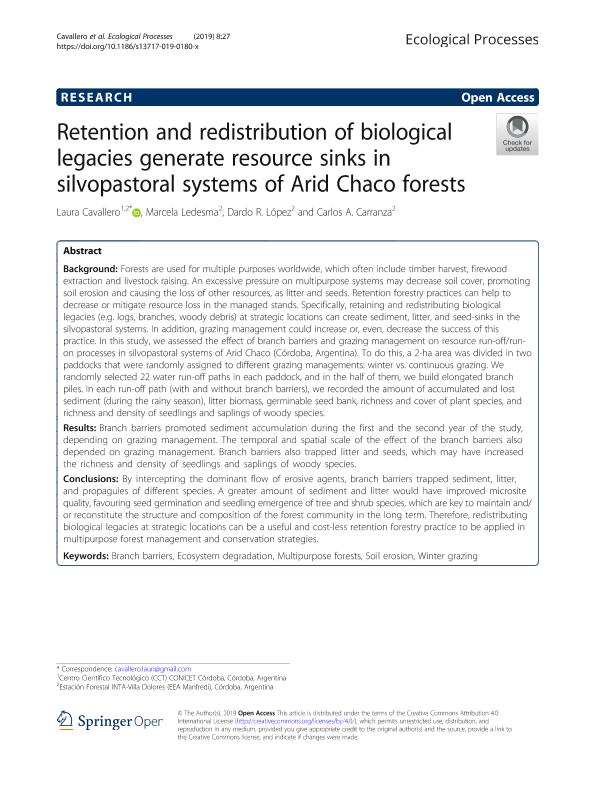Mostrar el registro sencillo del ítem
dc.contributor.author
Cavallero, Laura

dc.contributor.author
Ledesma, Marcela

dc.contributor.author
López, Dardo Rubén

dc.contributor.author
Carranza, Carlos Andrés

dc.date.available
2021-04-14T22:25:54Z
dc.date.issued
2019-07-11
dc.identifier.citation
Cavallero, Laura; Ledesma, Marcela; López, Dardo Rubén; Carranza, Carlos Andrés; Retention and redistribution of biological legacies generate resource sinks in silvopastoral systems of Arid Chaco forests; Springer Verlag Berlín; Ecological Processes; 8; 27; 11-7-2019; 1-16
dc.identifier.uri
http://hdl.handle.net/11336/130051
dc.description.abstract
Background: Forests are used for multiple purposes worldwide, which often include timber harvest, firewood extraction and livestock raising. An excessive pressure on multipurpose systems may decrease soil cover, promoting soil erosion and causing the loss of other resources, as litter and seeds. Retention forestry practices can help to decrease or mitigate resource loss in the managed stands. Specifically, retaining and redistributing biological legacies (e.g. logs, branches, woody debris) at strategic locations can create sediment, litter, and seed-sinks in the silvopastoral systems. In addition, grazing management could increase or, even, decrease the success of this practice. In this study, we assessed the effect of branch barriers and grazing management on resource run-off/runon processes in silvopastoral systems of Arid Chaco (Córdoba, Argentina). To do this, a 2-ha area was divided in two paddocks that were randomly assigned to different grazing managements: winter vs. continuous grazing. We randomly selected 22 water run-off paths in each paddock, and in the half of them, we build elongated branch piles. In each run-off path (with and without branch barriers), we recorded the amount of accumulated and lost sediment (during the rainy season), litter biomass, germinable seed bank, richness and cover of plant species, and richness and density of seedlings and saplings of woody species. Results: Branch barriers promoted sediment accumulation during the first and the second year of the study, depending on grazing management. The temporal and spatial scale of the effect of the branch barriers also depended on grazing management. Branch barriers also trapped litter and seeds, which may have increased the richness and density of seedlings and saplings of woody species. Conclusions: By intercepting the dominant flow of erosive agents, branch barriers trapped sediment, litter, and propagules of different species. A greater amount of sediment and litter would have improved microsite quality, favouring seed germination and seedling emergence of tree and shrub species, which are key to maintain and/ or reconstitute the structure and composition of the forest community in the long term. Therefore, redistributing biological legacies at strategic locations can be a useful and cost-less retention forestry practice to be applied in multipurpose forest management and conservation strategies.
dc.format
application/pdf
dc.language.iso
eng
dc.publisher
Springer Verlag Berlín

dc.rights
info:eu-repo/semantics/openAccess
dc.rights.uri
https://creativecommons.org/licenses/by/2.5/ar/
dc.subject
BRANCH BARRIERS
dc.subject
ECOSYSTEM DEGRADATION
dc.subject
MULTIPURPOSE FORESTS
dc.subject
SOIL EROSION
dc.subject
WINTER GRAZING
dc.subject.classification
Silvicultura

dc.subject.classification
Agricultura, Silvicultura y Pesca

dc.subject.classification
CIENCIAS AGRÍCOLAS

dc.title
Retention and redistribution of biological legacies generate resource sinks in silvopastoral systems of Arid Chaco forests
dc.type
info:eu-repo/semantics/article
dc.type
info:ar-repo/semantics/artículo
dc.type
info:eu-repo/semantics/publishedVersion
dc.date.updated
2021-03-25T13:57:07Z
dc.identifier.eissn
2192-1709
dc.journal.volume
8
dc.journal.number
27
dc.journal.pagination
1-16
dc.journal.pais
Suiza

dc.description.fil
Fil: Cavallero, Laura. Consejo Nacional de Investigaciones Científicas y Técnicas. Centro Científico Tecnológico Conicet - Córdoba; Argentina. Instituto Nacional de Tecnología Agropecuaria. Centro Regional Córdoba. Estación Experimental Agropecuaria Manfredi. Estación Forestal Villa Dolores; Argentina
dc.description.fil
Fil: Ledesma, Marcela. Instituto Nacional de Tecnología Agropecuaria. Centro Regional Córdoba. Estación Experimental Agropecuaria Manfredi. Estación Forestal Villa Dolores; Argentina
dc.description.fil
Fil: López, Dardo Rubén. Instituto Nacional de Tecnología Agropecuaria. Centro Regional Córdoba. Estación Experimental Agropecuaria Manfredi. Estación Forestal Villa Dolores; Argentina
dc.description.fil
Fil: Carranza, Carlos Andrés. Instituto Nacional de Tecnología Agropecuaria. Centro Regional Córdoba. Estación Experimental Agropecuaria Manfredi. Estación Forestal Villa Dolores; Argentina
dc.journal.title
Ecological Processes
dc.relation.alternativeid
info:eu-repo/semantics/altIdentifier/url/https://link.springer.com/article/10.1186/s13717-019-0180-x
dc.relation.alternativeid
info:eu-repo/semantics/altIdentifier/doi/http://dx.doi.org/10.1186/s13717-019-0180-x
Archivos asociados
